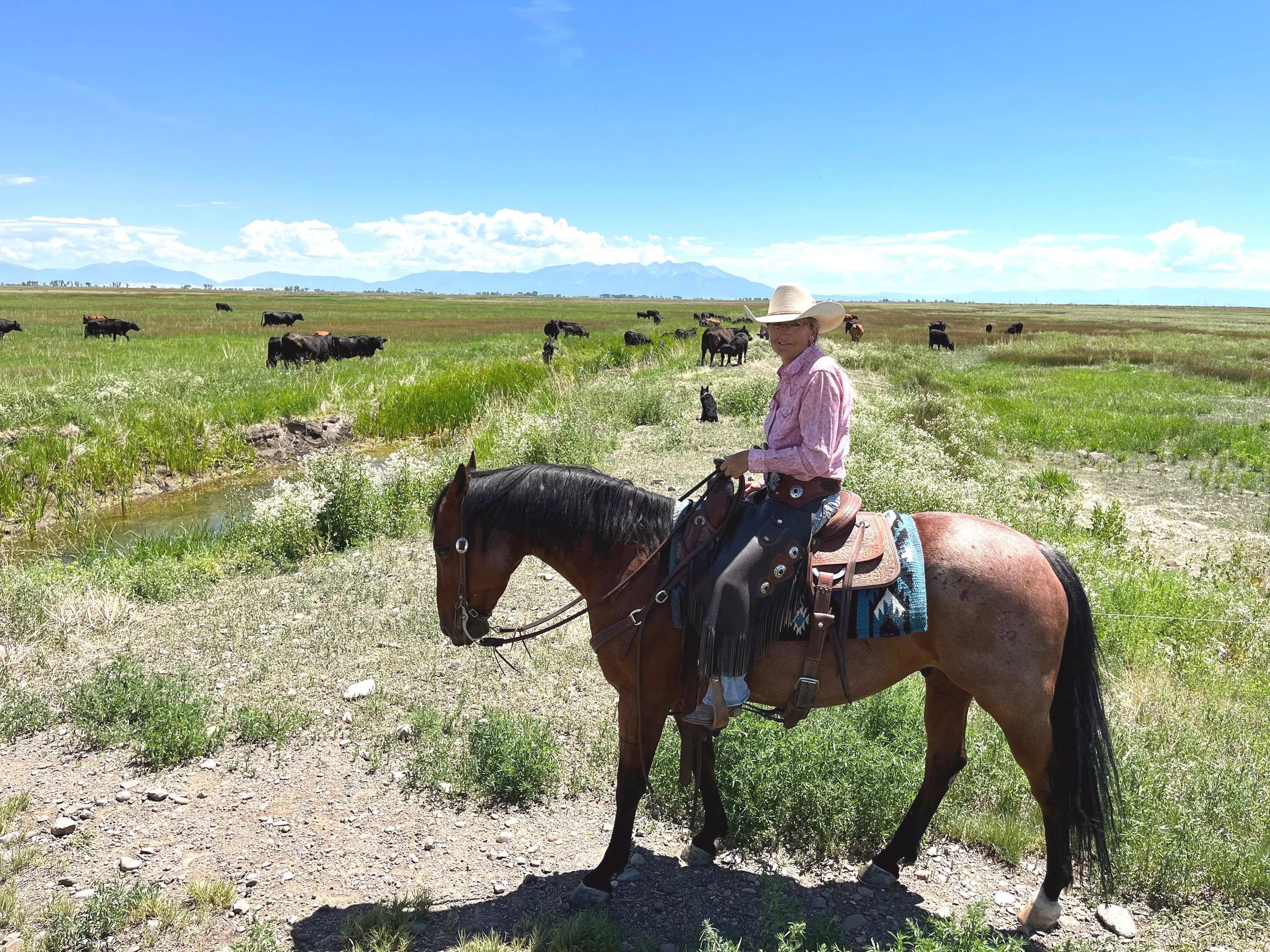Stories: Learning from Landowners
Landowners are the best stewards of the land and have much to teach others about conservation. Why did they choose to conserve their land? What’s involved? How will their actions serve Colorado in the future? The stories here answer these questions and more - elevating the voices of landowners and sharing their successful approaches.
A few key topics you’ll read about: Water loss, regenerative grazing, experimentation with crops and irrigation, partnerships, native plants and wildlife habitat protection, wildfire mitigation and restoration, forest and wetlands management, climate resilience, building agricultural and conservation leaders, tribal lands protection, experiential education, historic and cultural preservation, family estate settlements and planning, and more.
Many thanks to these landowners for sharing their experiences and stories - and to our land trust partners who collaborated with us!
Evan and Kim Ela had stayed several times at the organic peach farm his friend Thomas Cameron owned and operated since the early 1980s. When an opportunity arose to purchase some shares in the farm, Evan took it – but he also saw another opportunity: protecting the farm and its infrastructure so that it would always remain in agricultural production. Today, Thomas’s daughter, Gwen, is the lead farmer at Rancho Durazno. This second-generation farmer – she learned the ropes from her dad – is intentional about growing organically. But Gwen is also making the mission her own: Her innovative approach is about responsibly supporting and serving the migrant workers the farm relies on to succeed.
Anyone who has driven through the quaint Park County community of Lake George has seen the spectacular views of the South Platte River along Highway 24. Given its picture-perfect location and ample recreational and fly-fishing opportunities, the area could be a prime location for building homes or subdivisions. For years, purchasing the property – part of the historic Abell Ranch – was John Gunn’s dream every time he drove through the community. Rather than develop, however, he envisioned permanently protecting the land for the benefit of the community, the passersby and the wildlife. His vision came to fruition when he found the means to protect this iconic Front Range ranch forever.
Montezuma County is a beautiful patchwork of landscapes in Colorado’s southwest corner, and the people who live in the region are as diverse and varied as the landscapes themselves. Many of them are finding common ground in their shared interest to restore and preserve the land. In particular, three groups — the Ute Mountain Ute Tribe, Montezuma Land Conservancy and Trees, Water, People — are joining forces to protect the land and, in turn, help some members of the Ute Mountain Ute Tribe preserve the habitats and culturally important plants that play a role in their everyday lives.
Southern Plains Land Trust, located near Lamar on the southeastern plains, is focused on “rewilding” the prairie – and bison are at the center of this work. The bison are an essential contributor to a healthy ecosystem because they move across the landscape, grazing some areas more heavily and some more lightly, thereby creating a mosaic of plant communities. Bison are specially adapted to the Great Plains, feeding on the dense and deep-rooted native plant species like blue grama and buffalograss, which are abundant in the shortgrass prairie.
As Coloradans are unfortunately aware, wildfires are now a constant threat throughout the state – and not just in heavily wooded or tree-dense areas. The May family knows this all too well. They’ve been ranching and farming near Lamar, Colorado in the southeastern part of the state for over three generations. Their 16,000-acre ranch is recognized nationally for its sustainability and conservation efforts, but in spring 2022, a wildfire ripped through the Mays’ land, burning 10,000 acres – decimating the landscape and killing many of the animals that called the land home. They are investigating how to restore the land to the way it was before the disaster. It will be no small feat – though by September 2022, signs of resilience and successful restoration were already visible.
Colorado has countless properties and homes with stunning views and abundant access to the backcountry. An increasing number of them offer those things with renewable and solar energy options as well. But there are very few that check both of those boxes and provide pieces of history alongside prolific wildlife. Marjorie Westermann is proud to call one of these places home. Given its beautiful location and abundance of treasures, it’s no wonder she felt called upon to protect it from subdivision or development by placing it in a conservation easement.
For Kip Gates, there has never been a question about what he was meant to do. This fifth-generation rancher, who lives in Eagle County near Burns, was born to be a cowboy. In his day-to-day work running a 1,500-acre ranching operation, Kip is grateful for his ancestors’ work to make the family ranch what it is today. He’s also grateful the land is under a conservation easement that will protect it from subdivision or development for the long term. In addition to preserving his family’s legacy, the easement protects the land’s agricultural aspects as well as wildlife habitat for elk, deer, bears, mountain lions, eagles and, recently, moose.
While many Coloradans live within a short drive of a forested area, few are aware of the beautiful and delicate ecosystem that exists once they step into one. Beverly Parsons would like to see that change; she sees a greater understanding of the forest as a step toward fighting the impacts of a changing climate. She and her husband have seen firsthand how changes in the environment have impacted plants and wildlife - and have changed how they think about nature and wildfires after the East Troublesome fire almost destroyed their mountain home.
As more and more people are moving away from rural Colorado and the agricultural lifestyle, Montezuma Land Conservancy is cultivating the state’s next generation of leaders through a four-week agricultural program it runs for high school students. The program teaches youth about the land, agriculture and conservation. Students learn valuable leadership and teambuilding skills, develop knowledge about agricultural challenges, and gain insight into career opportunities.
Like much of the land in Montezuma County, MB and Chuck McAfees’ 2,300-acre ranch is a mix of dry farmland and rough, rocky terrain dotted with cactus, junipers and other drought-tolerant plants. The McAfees’ property is also like many others in the region in that it is loaded with important cultural sites, some as small as one square foot where a piece of pottery or footing for a dwelling was found. It’s no surprise, given the history and beauty of the land that’s been in Chuck’s family for three generations, that the McAfees consider this property their legacy and wanted to protect it from development.
“The conventional wisdom used to be that placing a conservation easement on a property devalued it by some amount. I believe in many instances, that is no longer the case. Depending on a person's perspective, I think there are folks out there who see conservation easements as a value-added feature, especially if their neighbors have one too. Easements can also help farmers and ranchers stay in business or even help newbies get into the business in a very competitive market.” – Peter Clark, rancher in the San Luis Valley.
Chris Sammons’ great-grandfather settled in the Kremmling Valley and started a ranching operation more than 120 years ago. Working with Colorado Headwaters Land Trust, Chris has created a clear long-term plan for protecting the land. But putting the land into a conservation easement wasn’t something the family had explored until Chris’ dad unexpectedly passed away. “There were four kids but no plan on what to do. We turned to the land trust and a conservation easement to help us settle the family’s estate.”
When Deb and Mike Culig began searching for a place to retire, neither anticipated the beautiful property they purchased in Grand County would also turn them into alpaca ranchers. Yet, because the land they bought came with a conservation easement that protected the agricultural nature of the property, they ended up exploring multiple potential endeavors before taking on a pack of alpacas. Now, the couple has more than a dozen alpacas, an extensive haying operation, and a lease with a cattle rancher who grazes his herd on a portion of their land. The couple has also adopted regenerative agriculture practices.
In southwest Colorado, the town of Durango features a beautiful combination of scenic views, abundant wildlife, an outdoor-recreation wonderland, a local farming and ranching legacy, and tribal lands rich with historical and cultural artifacts and stories. But, like other Colorado gems, Durango’s popularity, combined with the effects of climate change, has significantly altered the landscape. Jennifer Thurston has seen the changes intensify over the decades. Today, she is getting help to protect an area that, without any action, would be at risk of disappearing.
For years, Karen Whitney drove past this stretch of the Yampa River, noticing the Mount Harris historical highway marker. Once a thriving mining town, the property had been closed to the public for more than six decades. Karen imagined what it would be like to protect it - and acted on her vision. “Conserving this space reverses the trend compared to the rest of the country. Wild places have been developed, but this formerly developed area is now a wild place.”
In the larger San Luis Valley, more than 50 percent of the population is Hispanic. When Josie approached Rio Grande Headwaters Land Trust to help conserve her family's ranch, it was a chance to protect this unique piece of land, and also build more relationships and trust with a community that is often overlooked in the conservation arena. And Josie was driven: "They're not making any more land. We need to do what we can to protect it.”



























